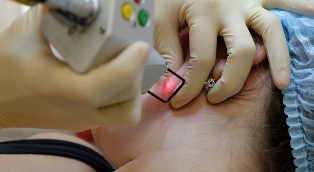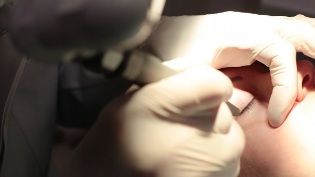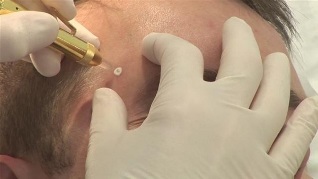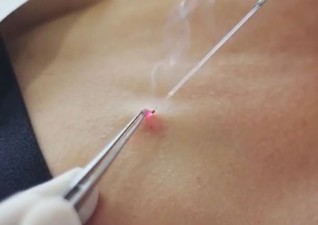
Removing a tumor with a solvent is a very common and effective method that helps to get rid of unwanted growth. This is a relatively new method, which appeared in the doctors' arsenal not so long ago, but has already managed to prove its advantage over other methods of removal. Precursors to laser destruction were removal with liquid nitrogen, electricity or scalpel. All of this could cause the patient significant discomfort while the laser remover shows good results with painless intervention.
Why remove
Papillomas, which are growths of various shapes and sizes, are usually benign tumors. They are localized on the mucous membrane of the user or his skin. The main reason for their appearance is the action of papillomavirus, in most cases, transmitted at sexual intervals.
Removing these structures performs several tasks at once:
- Aesthetic correction.A developing patient can be uncomfortable with their excessive attention from others. As a result, an individual may experience insecurity and discomfort, even if the growth is not endangered.
- Injury Prevention.If the growth is in a traumatic place where the patient constantly touches it, it can lead to separation of the protruding part. In addition, when trying to cover the papilloma with clothing, rubbing the affected area can be such a problem. This is accompanied by an injury to the papilloma and a possible infection as a result. The damage can lead to the penetration of microorganisms, which can cause inflammation in the wound. If this happens, the damaged area must be treated with peroxide and immediately go to a health center to remove the remaining part of the papilloma.
- Reducing the risk of cancer.Despite the fact that growth is benign in nature, there are so many manifestations of them as warts. They are usually located in close proximity and create a high risk of developing cancer. To prevent the disease, all warts must be removed.
Do not remove the structure on your own. All attempts to bind papilloma with threads, comb, apply some kind of chemical on it can worsen its condition.
Benefits of the procedure
Laser destruction has several advantages over other removal methods.This includes:
- Responsibility result.Thanks to the effect of the solvent, the growth is completely removed and leaves nothing even in the deep layer under the skin. The device penetrates deep enough to clear all traces of the presence of tumors.
- Pain.Exposure to the solvent gives the patient minimal pain. If you add anesthesia with local anesthetics to the operation, there is no pain.
- Action Speed . Removal of papillomas with solvent requires 2 to 5 minutes per element.
- Not aggressive.The laser beam is in a designated area and does not extend beyond it. In this case, more than one part of the solvent does not touch the place of the procedure. This is very important as this method helps to minimize the risk of infection and gives a great responsibility for infertility.
- No scar after surgery.If the work is done correctly, there should be no trace of the laser operation at the exposure site. This is because the tissue in question evaporates completely and then new, undamaged skin takes its place.
- Bloodless way to destroy.The laser beam heats the capillaries that supply blood and quickly closes their walls. As a result, bleeding stops and does not resume after surgery.
- Suitable for different body parts.Not all transport methods can be used on all body parts. Close places, eyelids, etc. are considered particularly sensitive. Laser destruction works well in the construction of such areas due to the accuracy of the laser beam.
All of these factors make laser removal one of the most popular methods of getting rid of growth.
Contraindications
The list of contraindications for this method is not as long as for other methods of destruction.Among the bans on laser removal:
- diabetes;
- oncology;
- exacerbation of chronic diseases;
- epilepsy;
- diseases associated with endocrine disorders;
- poor blood clotting;
- HIV or AIDS;
- acute inflammatory diseases.
In addition, patients who have recently had the flu or acute respiratory infections should also postpone the procedure for some time.
Method Description
Before starting a procedure to remove growth, will disinfect the area to be entered. In some cases, analgesics are used with local anesthetics. Ointment or spray is usually used for this. After the anesthetic has been applied, 2-3 minutes pass and the transfer process begins.

The laser beam is directed to the affected area and is said to cauterize unwanted growth. At this moment, the contents of the cells evaporate under the influence of the solvent and remove each layer of the tissue in question. This does not only happen in accessible places in open spaces. The procedure for removing the papilloma, for example on the eyelid, is the same. The only nuance in this area is that a special cooling method is used for the patient to prevent pain and burns in this sensitive area.
Tumors in nearby areas are removed according to the same principle. But here the doctor usually uses anesthetics as an anesthetic and injects the growth from different angles.
Instant needle insertion can be painful, but after a few minutes the sensitivity in the affected area disappears completely and further treatment is painless.
The affected area turns into a small, bloodless wound. When the destruction is done, it is disinfected due to the work of the solvent. After removing the accumulation, your doctor will treat the affected area with potassium permanganate.
After the operation, the patient may have a slight redness, itching or mild tenderness at the site of papilloma removal.
These reactions are considered normal, as although the operation was not invasive, the integrity of the skin was disturbed.All discomfort should disappear completely 2-4 days after the operation.
Dry crust appears later over the wound. Underneath it is a layer of already healthy skin, so the protective shell can not be torn off until it falls off on its own. Otherwise, scars may be left on the skin and the recovery process itself may take longer.
Consequences
Complications following solvent depletion are rare. As a rule, their presence is related to diseases that the patient already has, which he did not cure before the operation. So, for example, if the patient had dermatitis, it may contribute to pigmentation. If the skin itself is very sensitive, there may be a slight redness associated with burns. During an allergic reaction, edema may occur at the site of exposure.
To rule out any side effects, it is important to consult your doctor before using any laser.
Care after the operation
After removal of the structure, the patient must follow the following rules:
- do not allow water to enter the wound for 2-3 days;
- avoid visiting saunas, baths and swimming pools;
- do not rub the damaged area with a towel;
- do not apply adhesive to the wound;
- do not treat instead of removing papilloma with scrubs, lotions containing alcohol;
- Avoid exposure to UV rays.
Several times a day it is necessary to do antiseptic treatment of the wound. This must be done until the scab is separated. This treatment should prevent infection and help to speed up the healing time.For treatment of the damaged area you can take iodine or a solution of potassium permanganate.
After the removal area can be treated with anti-inflammatory ointments.
Their actions aim to accelerate tissue regeneration, relieve inflammation and edema. Before choosing a particular remedy, it is best to consult a doctor.
Which method is better
Laser is not the only way to deal with unwanted growth. There are also other ways, including:

Cryodestruction.
Based on the removal of papillomas with liquid nitrogen. Due to the low temperature, the structure begins to collapse and eventually disappears completely. The method is effective but has some drawbacks. Among them, it is impossible to have complete control over the depth of action of nitrogen. The material can go very deep, touch a healthy area, or on the contrary have only a superficial effect, without affecting all the layers of the localization of the structure.
In addition, this method is characterized by:
- the possibility of postoperative scarring;
- painful feeling;
- inability to secure the result after the first operation.
Thus, laser destruction shows greater efficiency compared to cryodestruction. Elimination with solvent is less painful and more likely to ensure the desired results.
Radio wave transmission.
This erasure procedure is performed using a special device that acts on the papilloma via radio waves. This contributes to the structure being cut out due to the point effect of the radio knife. The accuracy of the procedure is very high so that the adjacent tissues are not affected. However, the risk of fire or infection is very low.
This method is suitable for removing minor ailments. It is very effective, which makes it as popular as laser destruction. Both methods are considered modern methods of papilloma removal and are equally well used in medicine.

Electric coagulation.
This method is based on the action of a high-frequency electric current acting on the papilloma directly at the site of damage. Electric coagulation is now considered a common but outdated method. This procedure allows you to prevent bleeding after the papilloma is removed by burning the blood vessels.
However, when high frequency current is used, patients experience pain that occurs even after anesthesia. This causes some patients to abandon electrotherapy and opt for laser removal as a more complete and painless procedure.
Estimated Cost
The price range depends not only on the area and clinic where the transfer is made, but also on the number, size and location of the growth that was removed.
Many clinics have a discount for removing tumors in bulk: the more a patient has, the cheaper it will be to remove one growth.
Getting rid of genital growth can be significantly more expensive than other parts of the body. Furthermore, each clinic does not provide such services due to the complexity of such treatment.














































































